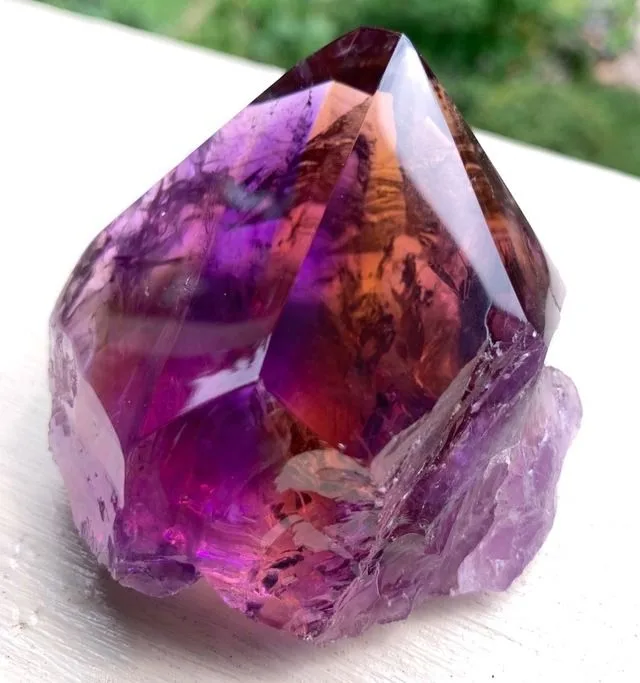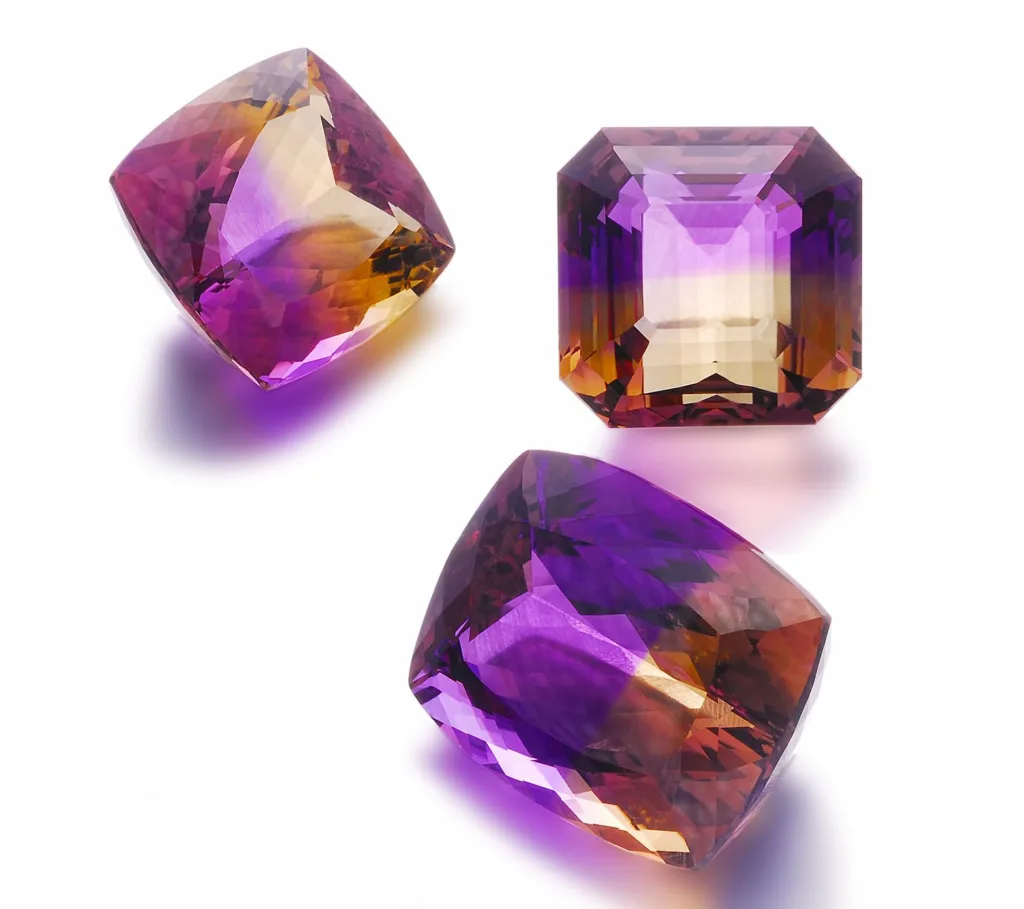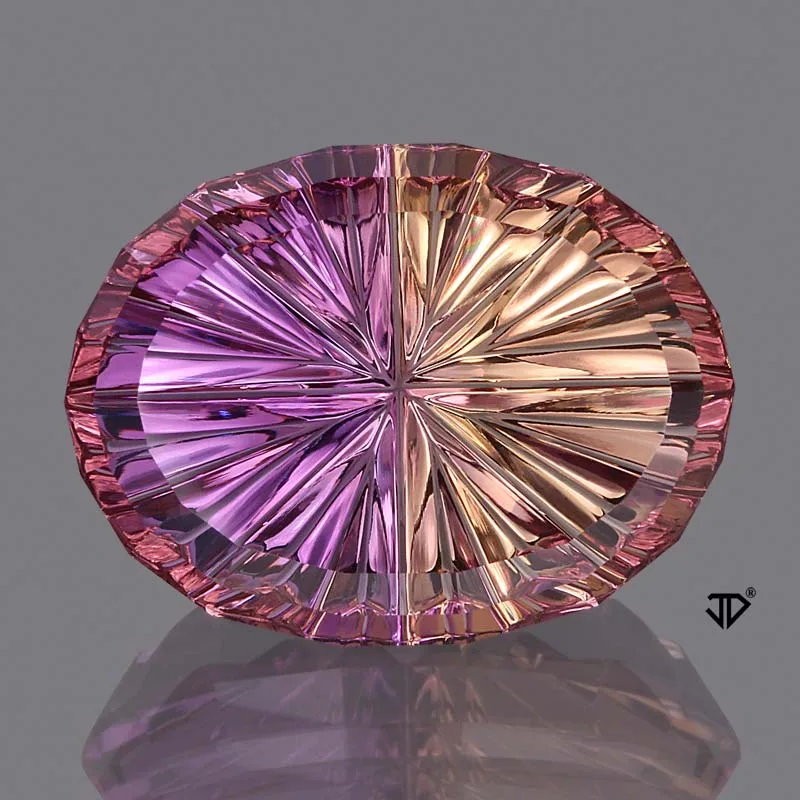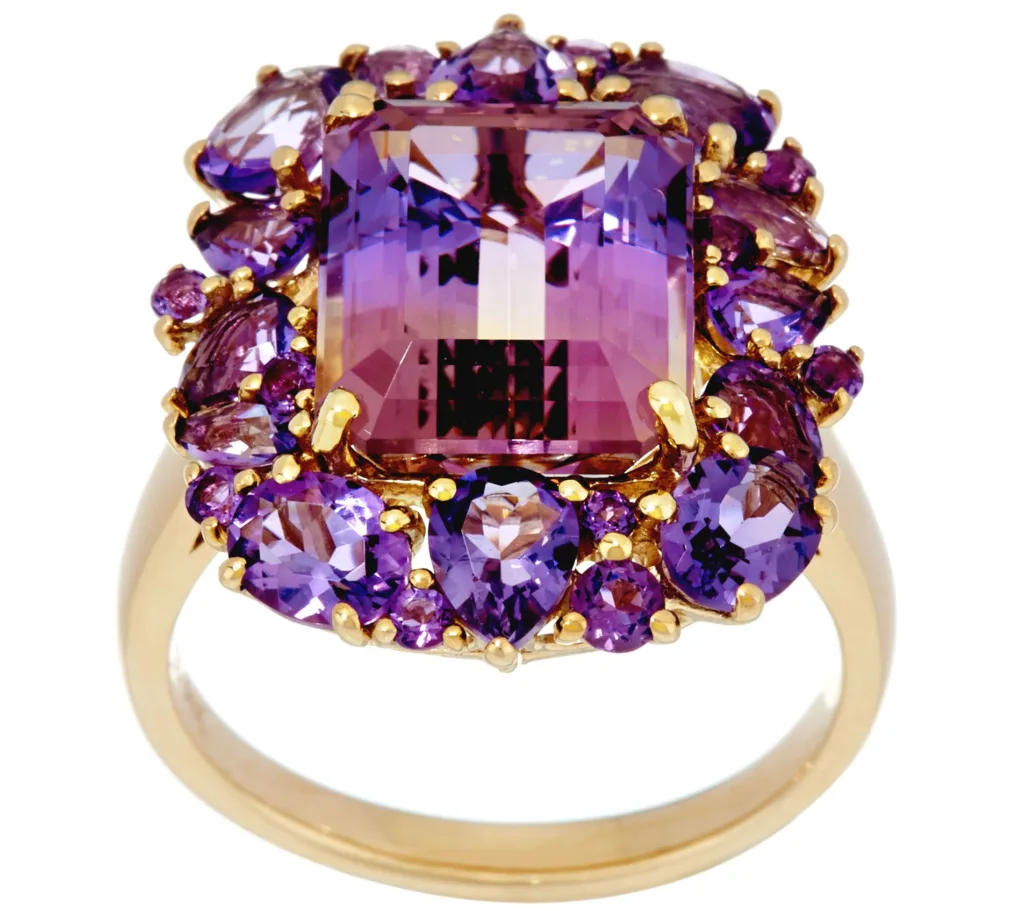Ametrine is a unique gemstone that combines the vibrant colors of amethyst and citrine. It is a variety of quartz that exhibits a distinct bicolored or tricolored appearance, with zones of purple and yellow or orange. The name “ametrine” is derived from a combination of “amethyst” and “citrine,” which are the two gemstones it comprises.



Ametrine is formed under specific geological conditions when amethyst and citrine crystals grow together within the same rock. This occurrence is relatively rare, making ametrine a less common gemstone compared to its individual components.
The purple color of ametrine comes from the presence of iron impurities within the quartz, which give amethyst its characteristic hue. The yellow or orange color is a result of the presence of iron in different oxidation states, which is responsible for the vibrant golden shades of citrine.
One of the most distinctive features of ametrine is its zoning pattern, where the colors are clearly separated into distinct sections rather than blending together. This natural division can result in various patterns, such as triangular or rectangular divisions, enhancing the gemstone’s uniqueness and visual appeal.
Ametrine is typically cut into faceted gemstones to showcase its vibrant colors and zoning patterns. It is often used in jewelry, including rings, pendants, earrings, and bracelets, as well as in ornamental objects. Its dual-color nature makes it versatile and complementary to both warm and cool color palettes.
Beyond its aesthetic value, ametrine is sometimes believed to possess metaphysical properties. It is thought to combine the calming and spiritual properties of amethyst with the energizing and abundance-attracting qualities of citrine. As a result, ametrine is sometimes associated with balance, clarity, creativity, and prosperity.
When caring for ametrine, it is recommended to avoid prolonged exposure to direct sunlight, as this can cause fading of the colors over time. Like other quartz gemstones, ametrine ranks 7 on the Mohs scale of hardness, making it durable enough for everyday wear.
Overall, ametrine stands out as a striking gemstone that harmoniously merges the allure of amethyst and citrine, offering a captivating blend of colors and properties.
Ametrine Origin and formation process

Ametrine has a fascinating origin and formation process. It is believed to form in a specific type of quartz crystal known as amethystine quartz, which occurs in certain regions where amethyst and citrine deposits overlap. The most well-known and significant source of ametrine is the Anahi Mine in Bolivia.
The formation of ametrine begins with the geological processes that create amethyst and citrine. Both amethyst and citrine are varieties of quartz, and their formation is primarily influenced by temperature, pressure, and the presence of certain chemical elements.
Amethyst forms in cavities or voids within rocks when silicon dioxide (SiO2)-rich fluids containing traces of iron and other impurities are exposed to specific temperature and pressure conditions. These conditions result in the growth of quartz crystals with a purple coloration due to the presence of iron impurities.
Citrine, on the other hand, is formed when amethyst undergoes heat treatment. Natural amethyst crystals exposed to high temperatures, such as those found in volcanic environments or subjected to geological processes like contact metamorphism, can transform into citrine. The heat causes the iron impurities to change their oxidation state, resulting in the vibrant yellow to orange hues characteristic of citrine.
Ametrine is formed when these two processes overlap. It occurs when amethyst and citrine crystals grow together in the same rock or cavity. This unique phenomenon is attributed to temperature variations and fluctuations in the iron content during crystal formation. As a result, ametrine displays distinct zones or sections with varying shades of purple and yellow or orange.
The Anahi Mine in Bolivia is renowned for its high-quality ametrine production. The geological conditions in this region have been conducive to the formation of ametrine for millions of years. It is believed that volcanic activity and hydrothermal processes played a significant role in creating the conditions necessary for the formation of ametrine deposits in Bolivia.
It’s important to note that while Bolivia is the most famous source of ametrine, this gemstone can also be found in other locations worldwide, including Brazil, Canada, and the United States.
Overall, the formation of ametrine is a natural occurrence that arises when amethyst and citrine crystals grow together, resulting in a stunning gemstone with a distinct color division and captivating beauty.
Physical Properties of Ametrine

- Color: Ametrine displays a combination of purple and yellow or orange colors due to the presence of amethyst and citrine within the same crystal. The color division can vary, ranging from distinct zoning patterns to more blended transitions.
- Transparency: Ametrine is typically transparent, allowing light to pass through the gemstone and enhancing its brilliance and sparkle. However, like other quartz varieties, it can also exhibit varying degrees of translucency.
- Hardness: Ametrine has a hardness of 7 on the Mohs scale. This means it is relatively durable and resistant to scratches and abrasions. However, it is still important to protect ametrine from hard impacts or contact with abrasive materials to prevent any potential damage.
- Crystal System: Ametrine belongs to the hexagonal crystal system, specifically the trigonal subclass. It forms as hexagonal prismatic crystals with a six-sided cross-section and pointed terminations.
- Refractive Index: The refractive index of ametrine ranges from approximately 1.544 to 1.553. This property influences how light bends or refracts when passing through the gemstone, contributing to its brilliance and luster.
- Specific Gravity: The specific gravity of ametrine typically falls between 2.65 and 2.91. This value indicates the density of the gemstone and helps distinguish it from other materials with similar appearances.
- Cleavage: Ametrine exhibits no cleavage, which means it does not have a natural tendency to break along specific planes. Instead, it displays a conchoidal fracture, resulting in smooth, curved surfaces when it breaks.
- Luster: Ametrine has a vitreous to sub-vitreous luster, giving it a glassy and reflective appearance when polished.
- Optical Properties: Ametrine is birefringent, meaning it can split light into two rays as it passes through the crystal. This property is a result of its trigonal crystal structure.
- Cut and Shape: Ametrine is commonly cut into faceted gemstones to showcase its dual-color zoning. The choice of cut can vary, but popular options include emerald cuts, ovals, rounds, and other traditional gemstone cuts that highlight the gem’s unique color combination.
These physical properties contribute to the overall beauty, durability, and value of ametrine as a gemstone. Its distinct coloration and captivating optical properties make it a sought-after gem among jewelry enthusiasts and collectors alike.
Geological Occurrence
Ametrine is a relatively rare gemstone and has specific geological occurrences associated with its formation. Here are the primary factors that contribute to the geological occurrence of ametrine:
- Overlapping Deposits: Ametrine forms in areas where deposits of amethyst and citrine overlap. This overlapping occurrence is relatively uncommon and requires specific geological conditions for both amethyst and citrine to develop simultaneously within the same rock or cavity.
- Quartz-Rich Environments: Ametrine is primarily found in regions with abundant quartz deposits. These areas often have geological histories involving volcanic activity, hydrothermal processes, or metasomatic alterations, which contribute to the formation of quartz-rich rocks and cavities.
- Temperature Variations: The formation of ametrine is influenced by temperature variations during crystal growth. Fluctuations in temperature affect the oxidation state of iron impurities within the quartz, leading to the distinct zoning and color division seen in ametrine.
- Hydrothermal Systems: Hydrothermal processes play a crucial role in the formation of ametrine. Hydrothermal fluids enriched with silicon dioxide (SiO2), iron, and other trace elements infiltrate cracks and cavities in rocks. These fluids provide the necessary chemical components for the growth of quartz crystals, including both amethyst and citrine, resulting in the formation of ametrine.
- Volcanic Environments: Certain volcanic environments can contribute to the formation of ametrine. Volcanic activity can create the necessary conditions for the growth of amethyst and citrine crystals, either through direct deposition or through subsequent heat treatments that transform amethyst into citrine.
- Specific Locations: The most famous and significant source of ametrine is the Anahi Mine in Bolivia. This mine has been renowned for its production of high-quality ametrine for several decades. Other countries that have reported ametrine occurrences include Brazil, Canada, and the United States, among others.
It is important to note that while ametrine can occur in specific geological settings, its occurrence is relatively rare compared to its individual components, amethyst and citrine. The precise combination of geological factors required for the formation of ametrine makes it a unique and sought-after gemstone among collectors and jewelry enthusiasts.
Composition and crystal structure

The composition of ametrine is primarily quartz, which is a form of silicon dioxide (SiO2). Quartz is one of the most abundant minerals in the Earth’s crust and has a chemical formula of SiO2, where one silicon atom is bonded to two oxygen atoms.
Ametrine is a variety of quartz that contains iron impurities responsible for its distinctive purple and yellow or orange colors. The presence of iron gives amethyst its purple color, while different oxidation states of iron result in the yellow or orange hues of citrine.
In terms of crystal structure, ametrine exhibits the same crystal structure as other quartz varieties. It belongs to the trigonal crystal system, specifically the hexagonal subclass. The crystal structure of quartz consists of tightly packed SiO4 tetrahedra, where each silicon atom is bonded to four oxygen atoms. These tetrahedra form a three-dimensional framework in which the oxygen atoms are shared between adjacent tetrahedra.
This arrangement gives quartz its unique properties, including its hardness, transparency, and ability to exhibit piezoelectric and pyroelectric effects. The crystal structure of ametrine contributes to its durability, crystal habit, and optical properties.
It’s worth noting that while the composition and crystal structure of ametrine are similar to other quartz varieties, its distinctive feature lies in the combination of amethyst and citrine within the same crystal, resulting in its captivating dual-color appearance.
Gemological Properties and Evaluation

Gemological properties and evaluation of ametrine involve assessing various factors to determine its quality and value. Here are the key aspects considered during the evaluation:
- Color: The color of ametrine is a crucial factor in its evaluation. The ideal ametrine displays a distinct and well-defined zoning pattern with vibrant purple and yellow or orange colors. The colors should be saturated, with good contrast between the purple and yellow/orange sections. The even distribution and intensity of color affect the desirability and value of ametrine.
- Clarity: Clarity refers to the presence of inclusions or flaws within the gemstone. Ametrine with high clarity, meaning fewer visible inclusions, is considered more valuable. However, some small inclusions are acceptable as long as they do not significantly affect the gem’s appearance or durability.
- Cut: The cut of ametrine plays a crucial role in maximizing its beauty and showcasing its color zoning. Skilled cutting techniques are employed to enhance the gem’s natural colors, symmetry, and overall brilliance. Well-cut ametrine gemstones with precise facet alignment and good proportions are highly regarded.
- Carat Weight: Carat weight refers to the size or mass of the ametrine gemstone. Larger, high-quality ametrine gemstones are rarer and generally more valuable. However, the value per carat may vary based on other factors such as color, clarity, and overall beauty.
- Luster and Transparency: Ametrine exhibits a vitreous to sub-vitreous luster, imparting a reflective and glass-like appearance. High transparency allows light to pass through the gemstone, contributing to its brilliance and sparkle.
- Optical Properties: Ametrine’s optical properties, such as refractive index and birefringence, affect its overall visual appeal. These properties determine how light interacts with the gemstone, resulting in its brilliance, dispersion, and play of colors.
- Durability: Ametrine has a hardness of 7 on the Mohs scale, indicating good durability. However, it is still important to consider the gem’s toughness, resistance to scratches, and potential for chipping or damage during wear and care.
- Origin: The origin of ametrine can influence its value and desirability. Ametrine from the Anahi Mine in Bolivia is highly regarded and often commands a premium due to its historical significance and reputation for producing high-quality ametrine gemstones. Other sources, such as Brazil or other countries, may also have their own characteristics and market values.
Gemological laboratories, gem experts, and gemstone grading systems such as the Gemological Institute of America (GIA) provide standards and guidelines for evaluating and grading ametrine based on these factors. It is important to note that personal preferences and market demand can also influence the value of ametrine.
Uses and Applications

Ametrine, with its unique dual-color combination and aesthetic appeal, has several uses and applications. Here are some common uses of ametrine:
- Jewelry: Ametrine is often cut and polished into faceted gemstones and used in various types of jewelry. It is popular for creating eye-catching rings, pendants, earrings, bracelets, and necklaces. Its vibrant colors and distinct zoning patterns make it a sought-after gemstone for those looking for unique and visually striking jewelry pieces.
- Ornamental Objects: Ametrine’s beauty and color variation make it a favored choice for ornamental objects. It can be incorporated into decorative items such as sculptures, figurines, art pieces, and home decor accents. Ametrine’s intriguing blend of purple and yellow/orange can add a touch of elegance and charm to any space.
- Collecting and Investment: Due to its rarity and unique nature, ametrine is often sought after by gemstone collectors and enthusiasts. Gemstone collectors appreciate ametrine for its natural beauty, dual-color zoning, and the challenge of finding high-quality specimens. Some individuals also view ametrine as an investment, expecting its value to appreciate over time.
- Metaphysical and Spiritual Purposes: Ametrine is sometimes associated with metaphysical properties and believed to possess certain spiritual benefits. It is thought to combine the calming and spiritual qualities of amethyst with the energizing and abundance-attracting properties of citrine. As a result, some people use ametrine for meditation, spiritual healing, balancing energies, and promoting personal growth.
It is worth noting that the primary use of ametrine is in the jewelry industry, where its beauty and uniqueness are highly valued. Whether it is incorporated into fine jewelry or used as a centerpiece in ornamental objects, ametrine adds a touch of elegance and individuality to various applications.
Famous Ametrine Specimens and Jewelry
While individual ametrine specimens may not have achieved the same level of fame and recognition as some other gemstones, there have been notable instances where ametrine has been incorporated into remarkable jewelry pieces. Here are a few examples:
- Empress of Uruguay: The Empress of Uruguay is one of the most famous ametrine specimens, which weighed around 2,600 carats. This massive ametrine crystal, discovered in Uruguay, displayed a stunning blend of deep purple and vibrant orange-yellow colors. While not made into a specific jewelry piece, the Empress of Uruguay showcased the captivating beauty and rarity of ametrine.
- Smithsonian Institution: The Smithsonian Institution in Washington, D.C., houses a collection of ametrine jewelry. This collection includes exquisite pieces that feature ametrine gemstones. These jewelry items demonstrate the skillful craftsmanship and creative designs that highlight the unique colors and zoning patterns of ametrine.
- Designer Jewelry: Various renowned jewelry designers have incorporated ametrine into their creations. Their designs often highlight the distinct colors and zoning of ametrine, showcasing the gemstone’s individuality. These jewelry pieces can be found in high-end jewelry stores and galleries, representing the artistry and craftsmanship of the designers.
- Private Collections: Many private collectors and jewelry enthusiasts possess stunning ametrine specimens and jewelry pieces. These collections showcase the diversity of designs and the range of creative possibilities when working with ametrine. While not widely known to the public, these collections contribute to the appreciation and popularity of ametrine within the gem and jewelry industry.
It’s important to note that specific ametrine specimens and their associated jewelry may gain prominence through exhibitions, auctions, or high-profile events. Additionally, jewelry featuring ametrine can be custom-made to cater to individual preferences and style.
While ametrine may not have reached the same level of fame as some other gemstones, its unique beauty and dual-color nature continue to captivate gemstone enthusiasts and collectors around the world.




































